
3-D Theatricals commemorates the one-hundredth anniversary of the death of thirteen-year-old Georgia factory worker Mary Phagan, along with the kangaroo court that subsequently found Jewish Northerner Leo Frank guilty of her murder and the lynch mob that ultimately robbed Frank of his own life, in its all-around phenomenal T.J. Dawson-directed revival of Jason Robert Brown and Alfred Uhry’s Parade.
Though hardly the first Southern California production of the 1998 double-Tony winner (for Brown’s score and Uhry’s book), 3-D’s big-stage, big-cast, big-budget Broadway-caliber production is the first to present Parade as it was originally intended, quite unlike the stripped-down U.K. version that played the Mark Taper Forum in 2009. If ever there were a musical in which size does indeed matter, Parade is that musical, and 3-D gives it all the panoramic scope it deserves while doing justice to the memory of a man who paid dearly for being different.
31-year-old Leo Frank’s antisemitism-fueled lynching remains today, a century later, one of the most horrendous miscarriages of justice in United States history. It’s no wonder, then, that Parade was a hard sell on Broadway. If Fosse was the “feel-good” musical of 1999, then a show with such grim subject matter as Brown and Uhry’s was pretty much its antithesis, and closed after 85 performances.
Still, Parade snagged those two Tonys, and deservedly so. Brown’s powerful, eclectic collection of songs run the gamut from gospel to pop rock to rhythm and blues to emotional ballads. Likewise, no one writes with more insight about being Jewish in the South than Uhry, whose book proves the playwright as adept at drama as Driving Miss Daisy and The Last Night Of Ballyhoo proved him at comedy. Uhry’s book moves back and forth through time, as flashbacks reveal the events leading up to Frank’s arrest and trial and we meet the musical’s many characters, each of whom played an important role in the case and each of whom gets his or her center-stage moment to shine.
 In a stirring prologue, a young confederate soldier (Jordan Lamoureux) on his way to war sings a hymn to Georgia, “The Old Red Hills Of Home,” by the end of which he has morphed into his elderly self (Robert W. Laur), a reminder that the Civil War was no distant memory at the time of Frank’s trial, but a very real one for the citizens of Atlanta.
In a stirring prologue, a young confederate soldier (Jordan Lamoureux) on his way to war sings a hymn to Georgia, “The Old Red Hills Of Home,” by the end of which he has morphed into his elderly self (Robert W. Laur), a reminder that the Civil War was no distant memory at the time of Frank’s trial, but a very real one for the citizens of Atlanta.
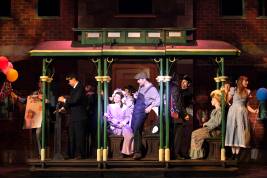 Parade’s tale of injustice then begins, with young Frankie Epps (Lamoureux) inviting pencil factory worker Mary Phagan (Valerie Rose Lohman) to “The Picture Show,” a date to which Mary never arrives. Since we have just seen her visit the office of factory manager Leo (Jeff Skowron) to claim her week’s meager wages in a scene that Parade’s book cuts deliberately short, it is left to us (and to the citizens of Marietta) to fill in the blanks, though in markedly different ways.
Parade’s tale of injustice then begins, with young Frankie Epps (Lamoureux) inviting pencil factory worker Mary Phagan (Valerie Rose Lohman) to “The Picture Show,” a date to which Mary never arrives. Since we have just seen her visit the office of factory manager Leo (Jeff Skowron) to claim her week’s meager wages in a scene that Parade’s book cuts deliberately short, it is left to us (and to the citizens of Marietta) to fill in the blanks, though in markedly different ways.
Evidence soon piles up against Leo, much of it coming from janitor Jim Conley (Rufus Bonds, Jr.), damning albeit falsified evidence that ultimately leads to his arrest for murder and the kangaroo court that was his trial. Meanwhile, Leo’s mouse of a Southern Jewish wife Lucille (Caitlin Humphreys) informs her flabbergasted husband of her intention to leave town during his trial, a decision whose ultimate reversal is merely the first step in Lucille’s transformation from cowardice to courage.
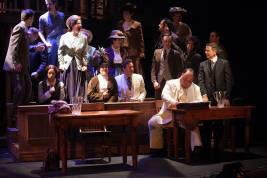 In court, prosecutor Hugh Dorsey (Norman Large) interrogates a trio of young factory girls (Renna Nightingale, Jenna Lea Rosen, and Brennley Brown) who testify under oath that Leo had invited Mary to “Come Up To My Office,” incriminating evidence accompanied by a vivid fantasy depiction of the sex fiend the townfolk of Marietta believe Leo to be. Mary’s mother (Jeanette Dawson) then takes the stand with the devastating “My Child Will Forgive Me,” after which, in a show-stoppingly jazzy “That’s What He Said,” Conley concocts the elaborate lie that seals Frank’s fate.
In court, prosecutor Hugh Dorsey (Norman Large) interrogates a trio of young factory girls (Renna Nightingale, Jenna Lea Rosen, and Brennley Brown) who testify under oath that Leo had invited Mary to “Come Up To My Office,” incriminating evidence accompanied by a vivid fantasy depiction of the sex fiend the townfolk of Marietta believe Leo to be. Mary’s mother (Jeanette Dawson) then takes the stand with the devastating “My Child Will Forgive Me,” after which, in a show-stoppingly jazzy “That’s What He Said,” Conley concocts the elaborate lie that seals Frank’s fate.
Broadway’s Parade featured a cast of 35, later cut down to 15 for its scaled-down London/Taper revival. While beautifully performed, that reduced-cast version lacked the scope of the original. Not only was the absence of the Marietta populace palpable, the casting of individual actors in as many as three different roles proved jarring to the point of confusion.
3-D Theatricals restores Parade to its original size plus one, a cast of 36 allowing director Dawson and company to do all those things the London production couldn’t, and audiences reap reward upon reward.
At the same time, no matter how grand in scale, no Parade can succeed without exceptional talents in its two leading roles, and in Skowron and Humphreys, 3-D’s Parade has found its perfect pair of leads.
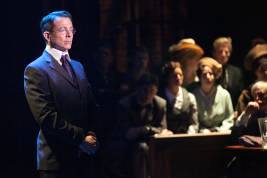 Slight of stature with eyes staring suspiciously (and even scornfully) out from behind horn-rimmed glasses, Skowron gives us a Leo so clearly “the other” that it’s no wonder this Jewish New Yorker found himself a stranger in a strange land. Skowron’s Leo is not an easy man to like, yet the Broadway vet never lets us lose sight of his humanity, and with pipes like Skowron’s, Leo’s “How Can I Call This Home?” and “It’s Hard To Speak My Mind” have never been more powerfully sung.
Slight of stature with eyes staring suspiciously (and even scornfully) out from behind horn-rimmed glasses, Skowron gives us a Leo so clearly “the other” that it’s no wonder this Jewish New Yorker found himself a stranger in a strange land. Skowron’s Leo is not an easy man to like, yet the Broadway vet never lets us lose sight of his humanity, and with pipes like Skowron’s, Leo’s “How Can I Call This Home?” and “It’s Hard To Speak My Mind” have never been more powerfully sung.
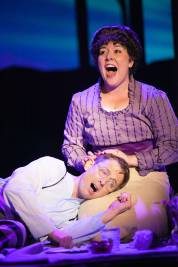 The role of Lucille is equally well-served by CSUF graduating senior Humphreys, whose youth proves a far better match with the real-life Lucille than the thirty-five-and-uppers who’ve mostly played her on Broadway and beyond. With an early 20something in the role, we understand Lucille’s initial desire to flee Leo’s trial, and when she becomes her husband’s most outspoken advocate, the distance she has traveled is all the more remarkable for having started out so meek and mild. That Humphreys acts up a storm and sings Lucille’s “You Don’t Know This Man” and “Do It Alone” every bit as richly as she plays the part is even more reason to celebrate her being cast in the role.
The role of Lucille is equally well-served by CSUF graduating senior Humphreys, whose youth proves a far better match with the real-life Lucille than the thirty-five-and-uppers who’ve mostly played her on Broadway and beyond. With an early 20something in the role, we understand Lucille’s initial desire to flee Leo’s trial, and when she becomes her husband’s most outspoken advocate, the distance she has traveled is all the more remarkable for having started out so meek and mild. That Humphreys acts up a storm and sings Lucille’s “You Don’t Know This Man” and “Do It Alone” every bit as richly as she plays the part is even more reason to celebrate her being cast in the role.
Surrounding Skowron and Humphreys are some of the finest performers and performances yet seen in a 3-D Theatricals production. E.E. Bell makes a pair of strong impressions as redneck defense lawyer Luther Rosser and as Officer Ivey. A dynamic Bonds reprises Jim Conley, the role he originated on Broadway, to powerful effect. Dawson sings “My Child Will Forgive Me” as heart-wrenchingly as I’ve heard it sung. A magnetic Zachary Ford is reporter Britt Craig, whose drunken “Big News” is one of Parade’s many show-stoppers. As power-hungry newspaper editor Tom Watson, the golden-throated Gordon Goodman is the evils of prejudice personified. Lamoureux is a standout, both in the production’s exquisitely sung prelude and as handsome, peppy Frankie Epps opposite the lovely Lohman’s doomed Mary Phagan. Large has never been better or more charismatic than he is as conviction-hungry prosecutor Dorsey, his “Somethin’ Ain’t Right” and “Twenty Miles From Marietta” making for a pair of Act One vocal highlights. Laur lends gravitas to the Old Soldier and passion to Judge Roan, and duets with Large a beautifully sung “The Glory,” a song added for Parade’s UK debut. Harrison White is heartbreaking as terrified night watchman Newt Lee in “I Am Trying To Remember.” Robert Yacko completes the cast of principals as fair-minded Governor Slaton, whose “Pretty Music” showcases his terrific tenor (and some fancy footwork opposite leggy dazzler Leslie Stevens as his wife Sally).
Brown, Nightingale, and Rosen shine as Leo’s three youngest accusers. Jenelle Lynn Randall does spellbinding work on the witness stand as the Franks’ maid Minnie. Danny Michaels has a delightful bit as prison guard Mr. Peavy. Joanna Jones (Angela) and David LaMarr (Riley) along with Bonds and White open Act Two with a soulfully performed “A Ramblin’ And A Rollin’.”
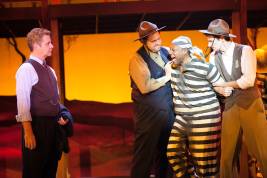 Completing the extraordinary ensemble are Connor Berkompas, Abby Bolin, Zack Crocker, Lisa Dyson (Lizzie), Allen Everman, Amy Glinskas, Micaela Martinez (Lyla), Sharie Nitkin, Kirklyn Robinson, Ryan Ruge, Natalie Sachse, William Shaffner, Allyson Spiegelman, Christopher Van Etten, and Andrew Ross Lynn (Floyd McDaniel).
Completing the extraordinary ensemble are Connor Berkompas, Abby Bolin, Zack Crocker, Lisa Dyson (Lizzie), Allen Everman, Amy Glinskas, Micaela Martinez (Lyla), Sharie Nitkin, Kirklyn Robinson, Ryan Ruge, Natalie Sachse, William Shaffner, Allyson Spiegelman, Christopher Van Etten, and Andrew Ross Lynn (Floyd McDaniel).
Despite some of the grimmest subject matter ever to serve as the basis of a Broadway musical, Parade features a surprising number of song-and-dance sequences, imaginatively choreographed Dana Solimando, highlights of which include the snappy “The Picture Show” and the creepy yet infectious “That’s What He Said.”
With musical director David Lamoureux conducting the big 3-D pit orchestra (provided by Los Angeles Musicians Collective), this may well be the best-sounding Parade ever, thanks also to sound designer John Feinstein.
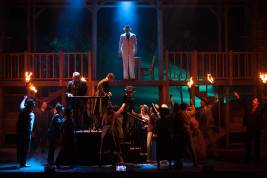 3-D Theatricals gives us a Parade designed “from the ground up,” and gorgeously so, beginning with Tom Buderwitz’s ingeniously conceived and executed set design, one which, along with Shon LeBlanc’s huge bevy of period costumes, looks absolutely sensational as lit to stunning perfection by a never-better Jean-Yves Tessier. Additional kudos go to prop designer Terry Hanrahan, wig designers Cliff & Kat Senior, and technical director Jene Roach. Lisa Palimire is production stage manager, Hanrahan assistant stage manager, and Esteven Valdes assistant choreographer.
3-D Theatricals gives us a Parade designed “from the ground up,” and gorgeously so, beginning with Tom Buderwitz’s ingeniously conceived and executed set design, one which, along with Shon LeBlanc’s huge bevy of period costumes, looks absolutely sensational as lit to stunning perfection by a never-better Jean-Yves Tessier. Additional kudos go to prop designer Terry Hanrahan, wig designers Cliff & Kat Senior, and technical director Jene Roach. Lisa Palimire is production stage manager, Hanrahan assistant stage manager, and Esteven Valdes assistant choreographer.
3-D Theatricals decision to play it considerably safer in its just-announced 2014 season of older standards (The Producers, Into The Woods, Damn Yankees, and Ragtime) makes 2013’s chancier, edgier slate of 9 To 5, Parade, Shrek The Musical, Funny Girl, and “A Show That Sets The Bar” all the more noteworthy, with Parade easily the riskiest of the bunch, but likely to prove the most rewarding as well.
Those in search of powerful, ground-breaking musical theater can do no better than to catch this unprecedented, unparalleled revival of Parade, one which does Jason Robert Brown, Alfred Uhry, and above all T.J. Dawson and 3-D Theatricals proud.
Plummer Auditorium, 210 E. Chapman Ave., Fullerton.
www.3dtshows.com
–Steven Stanley
May 11, 2013
Photos: Isaac James Creative


 Since 2007, Steven Stanley's StageSceneLA.com has spotlighted the best in Southern California theater via reviews, interviews, and its annual StageSceneLA Scenies.
Since 2007, Steven Stanley's StageSceneLA.com has spotlighted the best in Southern California theater via reviews, interviews, and its annual StageSceneLA Scenies.







 COPYRIGHT 2024 STEVEN STANLEY :: DESIGN BY
COPYRIGHT 2024 STEVEN STANLEY :: DESIGN BY